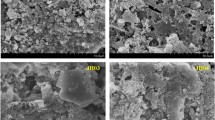Abstract
The results of laboratory modeling of transformations of the ionic forms of Hg and Cu are discussed. The processes considered include the formation of organic and inorganic complexes, sorption on mineral suspension and bottom sediment. A peak in the concentration of organic complex of metals is found to exist. Published data are used to study the physicochemical mechanism of metal transformations in the water–bottom sediment system and to develop a mathematical model of these processes. An explanation is given to the metal concentration peak, which forms in water as a result of the competition between complex formation and sorption processes. Comparison of the experimental and model curves allowed the evaluation of the kinetic coefficients of the complex formation and sorption stages.
Similar content being viewed by others
REFERENCES
Venitsianov, E.V. and Kudryasheva, Zh.N., Vodn. Resur., 1980, no. 2, p. 80.
Venitsianov, E.V. and Rubinshtein, R.N., Dinamika sorbtsii iz zhidkikh sred (Dynamics of Sorption from Liquids), Moscow: Nauka, 1983.
Lapin, I.V. and Krasyukov, V.N., Sovremennye problemy regional'noi i prikladnoi gidrokhimii (Current Problems of Regional and Applied Hydrochemistry), Leningrad: Gidrometeoizdat, 1987, p. 238.
Nakhshina, E.P., Mikroelementy v vodokhranilishchakh Dnepra (Microelement in Dnieper Reservoirs), Kiev: Naukova Dumka, 1983.
Solomin, G.A. and Lobchenko, E.E., Gidrokhim. Mater., 1968, vol. 48, p. 224.
Bachman, R.W., in Radioecology: Proc. 1st Natl. Symp., New York: Reinhold, 1963, p. 85.
Berner, R.A., J. Sediment. Petrol., 1981, vol. 51, no. 2, p. 359.
Button, K.S., Hostetter, H.P., and Mair, D.M., Water Res., 1977, vol. 11, no. 7, p. 539.
Irving, H. and Williams, R., Nature, 1948, no. 162, p. 746.
Kerndorff, H. and Schnitzer, M., Geochim. Cosmochim. Acta, 1980, vol. 44, p. 1701.
Krumbein, W.C. and Garrels, R.M., J. Geol., 1952, vol. 60, no. 1, p. 1.
Morgan, J.J. and Stone, A.T., Chemical Processes in Lakes, Stumm, W. and Werner, T., Eds., New York: Wiley, 1985, chap. 17, p. 389.
Sanchez, J. and Lee, G., Water Res., 1973, vol. 7, no. 4, p. 587.
Author information
Authors and Affiliations
Rights and permissions
About this article
Cite this article
Arkhipova, N.A., Venitsianov, E.V., Kocharyan, A.G. et al. Experimental Study and Mathematical Modeling of Hg and Cu Transformations in the Water–Bottom Sediment System. Water Resources 28, 63–67 (2001). https://doi.org/10.1023/A:1018832930923
Issue Date:
DOI: https://doi.org/10.1023/A:1018832930923




